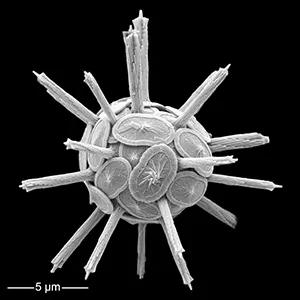Tiny ocean shells play a huge role in regulating Earth’s climate – Earth.com

Report on the Role of Calcifying Plankton in Climate Regulation and its Implications for Sustainable Development Goals
Executive Summary
A recent review conducted by an international research team highlights the critical, yet under-represented, role of calcifying marine plankton in global climate regulation. The omission of these organisms from standard Earth System Models (ESMs) leads to an incomplete understanding of the ocean’s carbon cycle. This report summarizes the key findings and underscores their direct relevance to achieving United Nations Sustainable Development Goals (SDGs), particularly SDG 13 (Climate Action) and SDG 14 (Life Below Water). Accurate climate projections, informed by comprehensive biological data, are essential for effective global policy and conservation efforts.
1.0 Introduction: The Overlooked Climate Regulators
Marine organisms that produce calcium carbonate (CaCO₃) shells, known as calcifying plankton, are fundamental drivers of ocean chemistry and the global carbon cycle. These organisms are crucial for meeting the objectives of SDG 14 (Life Below Water) by forming the base of many marine food webs and influencing ecosystem health.
Key Organism Groups
- Coccolithophores
- Foraminifers
- Pteropods
Despite their importance, these groups are often simplified or entirely omitted in the climate models used for global projections. This oversight presents a significant challenge to SDG 13 (Climate Action), as it compromises the accuracy of models designed to predict climate change and its impacts.
2.0 Key Research Findings
2.1 Influence on Ocean Chemistry and Carbon Sequestration
Calcifying plankton play a multifaceted role in biogeochemical cycles that are central to climate stability. Their life processes directly contribute to the ocean’s biological carbon pump, a key mechanism for long-term carbon storage.
- Regulation of Ocean Alkalinity: The formation and dissolution of their CaCO₃ shells directly influence the chemical balance of seawater.
- Carbon Transport: As these organisms die, their dense shells sink, transporting organic carbon from the surface to the deep ocean, where it can be sequestered for centuries. This process is vital for mitigating atmospheric CO₂ levels, a core target of SDG 13.
- Shallow Dissolution: A significant portion of CaCO₃ shells dissolve in the upper ocean, a process not well-represented in models. This alters local carbon cycling dynamics and affects the ocean’s capacity to absorb atmospheric CO₂.
2.2 Biological Diversity and Vulnerability
Current models often treat calcifying plankton as a single generic group, ignoring critical differences in their biology and vulnerability to environmental stressors. This lack of nuance hinders efforts under SDG 14 to protect marine biodiversity.
- Coccolithophores: As major CaCO₃ producers, they are highly sensitive to ocean acidification, a direct threat to marine ecosystems (SDG Target 14.3).
- Pteropods: These organisms build shells from aragonite, a more soluble form of CaCO₃, making them exceptionally vulnerable to declining pH levels.
- Foraminifers: This group faces combined threats from ocean warming, acidification, and deoxygenation.
3.0 Implications for Sustainable Development Goals (SDGs)
3.1 SDG 13: Climate Action
The exclusion of detailed plankton dynamics from ESMs creates a critical blind spot in climate science. To take urgent action to combat climate change, policymakers rely on accurate projections. Improving these models to reflect the ocean’s biological carbon pump is a necessary step to strengthen resilience and adaptive capacity to climate-related hazards (SDG Target 13.1).
3.2 SDG 14: Life Below Water
The research directly addresses the need to minimize and address the impacts of ocean acidification (SDG Target 14.3). Understanding how different plankton species respond to changing ocean chemistry is fundamental to conserving marine ecosystems. Accurate modeling can help predict tipping points and inform strategies to protect vulnerable marine life from the escalating impacts of climate change.
4.0 Recommendations and Future Outlook
4.1 Proposed Research and Development Actions
To address the identified gaps and enhance the accuracy of climate projections in line with the SDGs, the research community recommends the following actions:
- Refine global estimates of CaCO₃ production, dissolution, and export rates for each distinct plankton group.
- Conduct further laboratory and field studies to quantify how each group responds to multiple climate stressors, including warming, acidification, and oxygen loss.
- Translate these empirical findings into robust parameterizations for integration into the next generation of Earth System Models. This aligns with SDG 9 (Industry, Innovation, and Infrastructure) by advancing scientific research and technological capabilities.
4.2 Conclusion
Integrating the biological complexity of calcifying plankton into climate models is essential for developing credible climate mitigation and adaptation strategies. This research underscores that the planet’s smallest organisms have a large-scale impact on the climate system. Acknowledging their role is fundamental to achieving a sustainable future as envisioned by SDG 13 and SDG 14, ensuring the health of both our oceans and our climate for generations to come.
Analysis of Sustainable Development Goals in the Article
1. Which SDGs are addressed or connected to the issues highlighted in the article?
-
SDG 13: Climate Action
The article’s central theme is the regulation of Earth’s climate. It discusses how calcifying plankton influence the global carbon cycle and criticizes the omission of these organisms from current climate models, which are essential tools for understanding and predicting climate change. The entire discussion revolves around improving our understanding of the “Earth system responds to climate change.”
-
SDG 14: Life Below Water
The article focuses on marine organisms (coccolithophores, foraminifers, pteropods) and their role in ocean chemistry. It explicitly mentions threats to these organisms, such as “ocean acidification” and “warming,” and discusses their importance for ocean alkalinity and the transport of carbon to the deep sea. The health and function of these plankton are directly linked to the health of marine ecosystems.
-
SDG 9: Industry, Innovation and Infrastructure
The article calls for enhancing scientific research and upgrading technological capabilities. The critique of “Earth System Models” and the call to “translate those results into parameterizations for climate models” represent a push for scientific and technological innovation to create more accurate and comprehensive tools for climate projection.
-
SDG 17: Partnerships for the Goals
The research highlighted in the article was conducted by an “international team from the Institute of Environmental Science and Technology at the Universitat Autònoma de Barcelona (ICTA-UAB).” This exemplifies the international scientific cooperation needed to address complex global challenges like climate change.
2. What specific targets under those SDGs can be identified based on the article’s content?
-
SDG 13: Climate Action
- Target 13.2: Integrate climate change measures into national policies, strategies and planning. The article supports this target by emphasizing the need for more accurate climate models. Improved models, which include the biological processes of calcifying plankton, are fundamental for developing effective climate policies and strategies.
- Target 13.3: Improve education, awareness-raising and human and institutional capacity on climate change mitigation, adaptation, impact reduction and early warning. The research itself contributes to institutional capacity by deepening scientific understanding. Publishing this review raises awareness about a critical, overlooked component of the climate system.
-
SDG 14: Life Below Water
- Target 14.3: Minimize and address the impacts of ocean acidification, including through enhanced scientific cooperation at all levels. The article directly addresses this target by explaining how plankton like coccolithophores and pteropods are “particularly sensitive to acidification” and vulnerable to “low-pH conditions.” The study itself is an example of enhanced scientific cooperation aimed at understanding these impacts.
- Target 14.a: Increase scientific knowledge, develop research capacity and transfer marine technology… in order to improve ocean health. The article is a direct call to action to increase scientific knowledge. It advocates for “urgent efforts to refine estimates of production, dissolution, and export of calcium carbonate” and for laboratory and field studies to better understand marine ecosystems.
-
SDG 9: Industry, Innovation and Infrastructure
- Target 9.5: Enhance scientific research, upgrade the technological capabilities of industrial sectors in all countries… and substantially increase the number of research and development workers and public and private research and development spending. The article’s core recommendation is to enhance scientific research by integrating complex biological data into “Earth System Models,” which is a direct call to upgrade the technological capabilities used for climate science.
3. Are there any indicators mentioned or implied in the article that can be used to measure progress towards the identified targets?
- Implied Indicator for Target 13.2: Inclusion of biological carbon pump dynamics in national and international climate models (e.g., Earth System Models used in the Coupled Model Intercomparison Project). The article’s main critique is that these models “simplify or omit the diverse group of calcifying plankton.” Progress would be measured by the successful integration of these processes into the models used for policy-making.
- Indicator for Target 14.3: Average marine acidity (pH). The article explicitly mentions that pteropods are “vulnerable to low-pH conditions” and coccolithophores are sensitive to “acidification.” This implies that measuring ocean pH is a critical indicator for assessing the threat to these organisms.
-
Implied Indicators for Target 14.a:
- Quantification of group-specific production, dissolution, and export rates of calcium carbonate. The article explicitly calls for “urgent efforts to refine estimates” of these metrics.
- Data on the response of different plankton groups (coccolithophores, foraminifers, pteropods) to stressors like warming, oxygen loss, and acidification. The article states that “laboratory and field studies need to capture how each group responds” to these shifts.
- Implied Indicator for Target 9.5: Development of new parameterizations for climate models that incorporate calcifying plankton. The article states that researchers must “translate those results into parameterizations for climate models,” making the creation and adoption of these new parameters a clear measure of progress in scientific innovation.
4. SDGs, Targets and Indicators Table
| SDGs | Targets | Indicators |
|---|---|---|
| SDG 13: Climate Action | 13.2: Integrate climate change measures into policies and planning. | (Implied) Inclusion of biological carbon pump dynamics in Earth System Models. |
| SDG 14: Life Below Water | 14.3: Minimize and address the impacts of ocean acidification. | Average marine acidity (pH), as implied by the discussion of “low-pH conditions.” |
| 14.a: Increase scientific knowledge and research capacity to improve ocean health. | (Implied) Refined estimates of production, dissolution, and export of calcium carbonate by different plankton groups. | |
| SDG 9: Industry, Innovation and Infrastructure | 9.5: Enhance scientific research and upgrade technological capabilities. | (Implied) Development and integration of new parameterizations for calcifying plankton into climate models. |
Source: earth.com
What is Your Reaction?
 Like
0
Like
0
 Dislike
0
Dislike
0
 Love
0
Love
0
 Funny
0
Funny
0
 Angry
0
Angry
0
 Sad
0
Sad
0
 Wow
0
Wow
0


















































.jpg.webp?itok=0ZsAnae9#)





/environment-climate-change-and-health-(ech)/water-sanitation-hygiene-and-health-(wsh)/landfill-tuvalu-36092.tmb-1200v.jpg?sfvrsn=5c21fe40_1#)
















